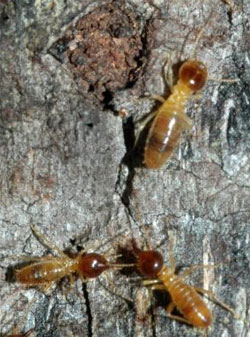?
Termites may produce cleaner biofuels
Termites may produce cleaner biofuels
mongabay.com
November 23, 2007
Termites may be the key to greener, more effective biofuels, report scientists writing in the November 22 edition of the journal Nature.
Termites harbor stomach microbes that produce enzymes which may be useful in converting wood or waste biomass to biofuels. Scientists from the U.S. Department of Energy Joint Genome Institute (DOE JGI), the California Institute of Technology, biofuels firm Verenium Corporation, INBio, the National Biodiversity Institute of Costa Rica, and the IBM Thomas J. Watson Research Center are working to sequence the genome of these gut microorganisms to better understand how energy could be produced from wood.
 Nasutitermes corniger termites photographed in Puerto Rico. Credit: David Gilbert, DOE Joint Genome Institute |
“Termites employ an array of specialized microbes in their hindguts to break down the cell walls of plant material and catalyze the digestion process,” said Dr. Raymond L. Orbach, Under Secretary for Science, U.S. Department of Energy. “Industrial-scale DNA sequencing by DOE JGI was key to identifying the genetic structures that comprise the tools that termites use. Our task now is to discover the metabolic pathways generated by these structures to figure out how nature digests plant materials. We can then synthesize the novel enzymes discovered through this project to accelerate the delivery of the next generation of cellulosic biofuels.”
The researchers analyzed the gut flora of termites from the Costa Rican rainforest and found two major bacterial lineages, treponemes and fibrobacters. They concluded that treponemes are responsible for breaking down wood and fermenting it into sugars that can then be fermented into fuels like ethanol.
While the findings have potential, the scientists say they are still a long way from commercialization of termite gut enzymes for biofuel production.
“Adapting these findings for an industrial-scale system is far from easy,” said Eddy Rubin, JGI Director. “Termites can efficiently convert milligrams of lignocellulose into fermentable sugars in their tiny bioreactor hindguts. Scaling up this process so that biomass factories can produce biofuels more efficiently and economically is another story. To get there, we must define the set of genes with key functional attributes for the breakdown of cellulose, and this study represents an essential step along that path.”